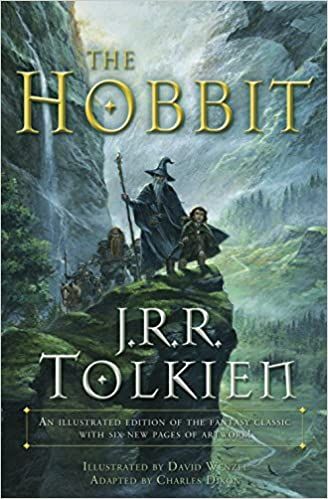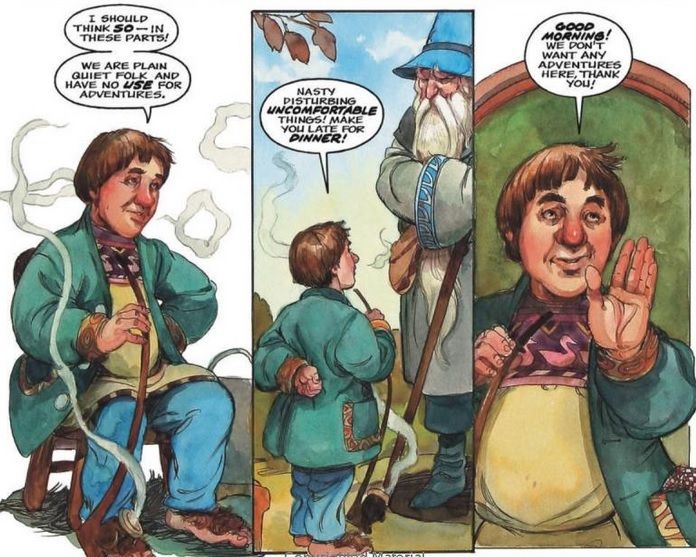Everyone knows that books can be adapted into movies. It happens all the time. But did you know they can be adapted into graphic novels, too? In this series, I’ll be taking a look at classic novels and their illustrated counterparts to determine what each did well, what each did wrong, and how they approach the same story decades apart and in such different media.
Grab your walking stick and don’t forget your pocket-handkerchief: today we’re heading to Middle Earth to explore J.R.R. Tolkien’s 1937 children’s book, The Hobbit!
Leonard Nimoy did a pretty fair job of summarizing this one, but just in case:
The wizard Gandalf tricks Thorin and his company of questing dwarves into hiring one Bilbo Baggins, a wealthy hobbit with no adventuring experience whatsoever, to accompany them on an adventure. After a long series of challenges in which Bilbo repeatedly proves his worth, they find the dwarves’ treasure and the dragon who stole it. Sadly, Thorin succumbs to gold lust and sparks a battle that ultimately kills him. But at least Bilbo got a neat ring out of it.
Now let’s see what the different versions did with that same story.
The Book
|
|
I love this book so much. It’s written in a simplistic style (it is for kids, after all), but it is so fun, clever (those riddling sessions!), and even exciting at times. I especially love Bilbo, who is the furthest thing from a fantasy hero you can imagine. He just wants to go home and eat toast. Most relatable adventurer ever.
That said, it’s hardly perfect.
The second biggest weakness to my mind is the lack of character development. Despite all the time Bilbo spends with them, the dwarves have no personalities to speak of — except Bombur, whose personality is “fat and lazy,” which, ew — and we learn next to nothing about them. (The Peter Jackson films, with their ridiculous running time, could have fixed this, but alas.)
The biggest weakness of all is that, once you know the dwarves were “based on” the Jewish people, lines like this get real uncomfortable real quick:
[D]warves are not heroes, but calculating folk with a great idea of the value of money; some are tricky and treacherous and pretty bad lots; some are not, but are decent enough people like Thorin and Company, if you don’t expect too much.
Chapter XII, “Inside Information”
The fact that everyone has a vague, instinctive dislike of dwarves for some reason is not presented as a problem or contradicted in any way. Come to think of it, I’m not fond of any system that decrees certain races/species to be inherently anything, good or bad. I get that you have to simplify things when writing for kids, but this pushes things too far for me.
It’s also anticlimactic to watch Bilbo and company go all that way, only for some random man we’ve never met before to take down Smaug while they’re hiding in a cave. (Jackson did, at least, solve that issue.) I can’t tell you how disappointed I was by this the first time I read the book.
The Comic
 |
Originally published in 1989, The Hobbit: An Illustrated Edition of the Fantasy Classic was adapted by Charles Dixon and illustrated by David Wenzel. It retains all of the key sequences from the original novel, but it does truncate them in places. For instance, it keeps the scene where the Company gets lost in Mirkwood, but it shortens the bit where they chase after the feasting elves, and it cuts entirely the bit where Bilbo climbs a tree to get his bearings. It also cuts out most of the songs.
All of the text is pulled right from the book. For my money, they could have made greater cuts and employed more of a “show, don’t tell” method of storytelling. They could have, say, actually shown how Bilbo’s sneezing nearly gave him away after he escaped from the wood-elves’ palace. Instead, they copy-pasted that passage over an image of the wine bottle he abandoned after running away to evade capture.
But I’m nitpicking now, as I do enjoy the graphic novel as it is. They could have cut the more antisemitic passages, though.
As for the art, it is absolutely gorgeous. The Hobbit offers endless opportunities for stunning visuals, and Wenzel does not disappoint. Bilbo and Company pass through so much striking scenery and meet so many weird characters, so the art has a big job to do, and it does it admirably.
The dwarves’ character designs, well, leave no doubt as to their Jewish origins. Also, I don’t want to turn into one of those insufferable nerds who throws a screaming fit at every tiny change from the source material, but Chapter I clearly states that Hobbits have curly hair. So why oh why does Bilbo look like he’s auditioning for a Beatles tribute band!?
 |
The only version allowed to get away with no-curls Bilbo is the Soviet TV movie, because it is cheap and hilarious and bad. Did Wenzel not know how to draw curls or something? In some ways, his attention to detail is amazing — he got the bit about Gandalf’s eyebrows extending past his hat brim exactly right — so this baffles me.
The Takeaways
Both versions are great fun and I strongly recommend them!
A couple people I’ve met complained that the novel is too slowly paced and, as a result, dull. I didn’t have that problem, but if you do, you might like the graphic novel better. It abbreviates the story quite a bit without losing the spirit of the original. Being able to actually see the scenery that Bilbo travels through rather than having it described in prose might be a welcome change for you, too (this was a point of contention with both people I talked to about the novel).
I’ve read and watched several adaptations of this story over the years, and I think it’s so solid that it’d be hard to adapt it in a way that didn’t offer at least a little value to fans. (Even if it’s just ironic, so-bad-it’s-good value, like the Soviet film.) I’ve enjoyed all of them in different ways, so either I’m easy to please, or The Hobbit is just that good of a story. Or both!
Check out previous Comic vs. Book showdowns: To Kill a Mockingbird
Source : Comic vs. Book: THE HOBBIT








